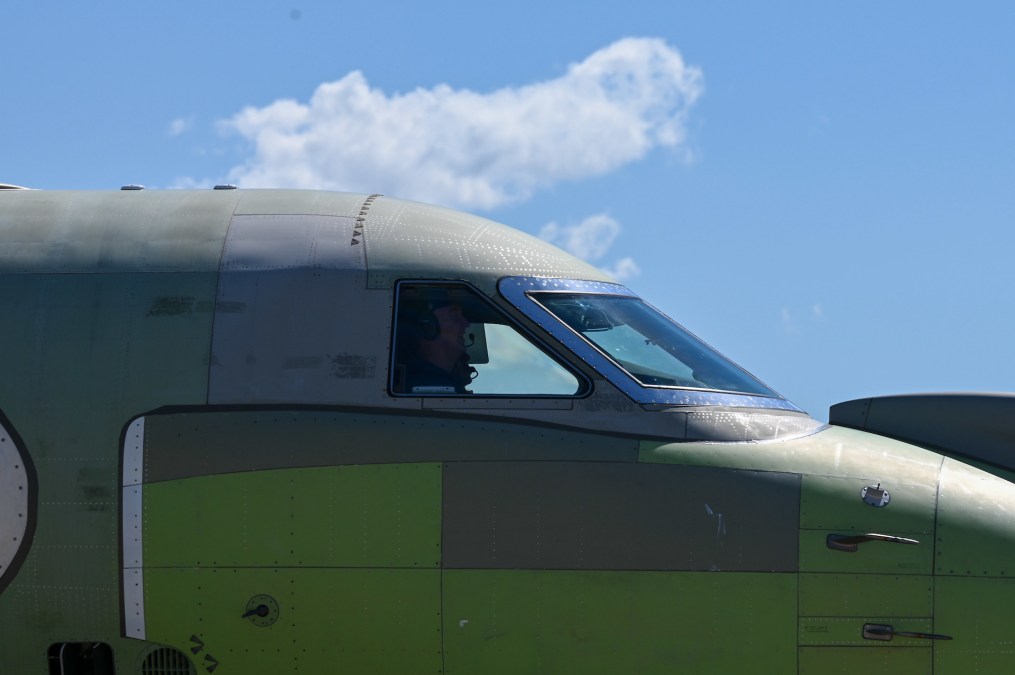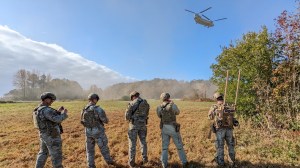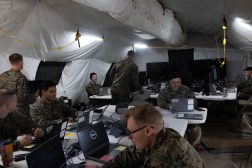Air Force looks to new concepts as it aims to advance its electronic warfare prowess

NATIONAL HARBOR, Md. — After years of neglect, the Air Force is seeking to reinvigorate its attention and investment in the electromagnetic spectrum. And senior officials are sharing their vision for what the future may hold.
“In order to align with the National Defense Strategy, the Air Force will need to embrace new concepts for EW and increased emphasis on the broader Electromagnetic Spectrum (EMS),” Gen. David Allvin, the nominee to be the service’s next chief of staff, wrote in a questionnaire that accompanied his confirmation hearing last week.
Current chief of staff and nominee to be the next chairman of the Joint Chiefs of Staff, Gen. Charles “CQ” Brown, has observed that the joint force as well as the Air Force have fallen behind in the spectrum, even going so far as to say the Air Force has been “asleep at the wheel” for the last 25 to 30 years.
“Over the past few decades, the Joint Force has lost some muscle memory defending against electromagnetic attack by conducting operations within a permissive electromagnetic spectrum. Over the same period, operations within this spectrum have changed significantly while our most advanced adversaries have done their best to rapidly evolve,” he wrote in a questionnaire that accompanied his confirmation hearing.
Following the end of the Cold War, the DOD largely divested of much of its high-end electronic warfare capabilities. Now, adversaries recognize the U.S. military’s dependence on the spectrum and its strategic importance. The joint force relies on the spectrum for communications and navigation — to include precision strike, GPS and data — and other nations have developed sophisticated systems to jam, spoof and confuse U.S. systems.
About six years ago, the Air Force embarked on a landmark study known as the Enterprise Capability Collaboration Team, that sought to dive deeper into the electromagnetic spectrum and develop reforms.
“This spectrum warfare is really integrating with the other traditional parts of warfare and ensuring that we can have our air superiority, we can support our strike missions, all those by not just managing spectrum, but protecting our own vulnerabilities and exploiting those who are adversaries,” Allvin told senators. “I see this as an expanding mission, because it is going to be part and parcel to the future of warfare. If we’re going to try and prosecute that many targets at that amount of time, we have to be able to dominate spectrum.”
Allvin outlined his vision for what the service needs when it comes to new approaches and tactics.
“My vision includes an Air Force with distributed software-defined systems and capabilities that are agile and increasingly leverage [artificial intelligence and machine learning] to move to more robust cognitive EW. These capabilities should enable updates at tactical speeds vice acquisition timelines in order to maintain advantage over any adversary employing complex systems,” he wrote in his questionnaire.
“To achieve this vision, the Air Force will need to explore, develop, and produce new and innovative concepts and doctrine that expand on historic electronic warfare principles in favor of Electromagnetic Spectrum Operations (EMSO), the merger of traditional Electronic Warfare with Spectrum Management. The current Cross-cutting Operational Enabler team commissioned by the Secretary of the Air Force will be instrumental in capability development to achieve this vision,” he added.
The cross-cutting operational enabler team is an add last year to Air Force Secretary Frank Kendall’s seven operational imperatives, and it includes mobility, electronic warfare and munitions.
“That was the first time that we looked at the spectrum as part of that,” Col. Leslie Hauck III, director of electromagnetic spectrum superiority at Air Force headquarters, told DefenseScoop in an interview at AFA’s Air, Space and Cyber conference. “If you go through every part of the OIs … you go through the Air Force operating concept, and if you were to draw out all those lines of effort and you put a checkmark where the spectrum is needed, it’s about everywhere. Having that as a cross-cutting across all the OIs has been huge, I think, for us to gain situational awareness on really where we should put the resources for EMSO, for electromagnetic spectrum operations.”
Collaboration
Hauck explained an approach based on collaboration: platform to platform, service to service, and between U.S. and allies. In other words, no one aircraft, service or nation will be successful on its own.
“We have to not just be a single platform that’s going out there fighting on its own. We got to connect this, we got to synchronize it, we have to collaborate and then we have to integrate it, so that we win,” he said. “To say, like, you need to put all your eggs in this basket and you’ll win, I don’t think it’s possible. You’ve got to choose the right investments across the board, and that’s what the OIs are intending to do … A world where everybody could have everything [would] be pretty sweet, but that’s not reality.”
From the Air Force’s perspective, a variety of aircraft will be used in concert, depending on the mission, he said.
“Whether it be [collaborative combat aircraft], whether it be the next-generation air dominance family systems, whether it be B-21 family of systems, whether it be space, whether it be — I can keep going, right, you name a platform, the Rivet Joint, whether it be the E-7 coming online, they all have a place in this,” he said. “You take one away, you’re going to be hurting. But if you just put one out there on its own, you’re also going to be hurting.”
So-called collaborative combat aircraft (CCA) are drones that are part of the Air Force’s vision for robotic, uncrewed wingmen to accompany manned aircraft into battle. Though experimentation with the technology has been ongoing, the operating concept is still being fleshed out. As such, it’s unclear what role these systems could play in electronic warfare, though officials have hinted it’s very likely they’ll have a part at some point in the future.
“I’d love to have wingmen that didn’t have a body [in them] that I could send forward into a higher threat area to take care of whatever’s out there,” Hauck said. “Just like we’ve had [the Miniature Air Launched Decoy-Jammer] in the past to go out there and confuse the enemy and let them see tracks that may not be a real asset or whatever else, so that we can get the real attack in, those are all parts of what CCA is going to bring us.”
When it comes to long range or standoff jamming, Hauck acknowledged this was an area the Air Force took its attention away from during the post-9/11 counterterrorism wars.
“There’s not one easy answer either, and you have to still make choices along the way on how you might be able to do that standoff jamming most effectively,” he said. The EC-130 Compass Call “wasn’t out there [in Afghanistan] doing the stuff that we needed it to do in the future fight as we look to a peer competitor and the pacing challenge that’s out there.”
The Air Force will be exploring the potential of the B-52 bomber to take on long-range jamming in upcoming experiments, which Hauch described as one possible solution. They will be experimenting with the Navy’s ALQ-249 pod, the first of its so-called Next Generation Jammer program. Hauck noted that the Navy did not take its eye off the standoff EW fight over the years and has continued to invest in this mission.
He added that the EC-37B, the next-generation Compass Call, could be another capability in the arsenal. The first 10 of those aircraft were delivered to the force, contractors BAE and L3Harris announced last week.
Ultimately, these systems must come together in a joint fashion and be part of a joint force commander’s tool kit.
However, it’s not always that simple.
“I wish it was that easy. I wish we really just flip a switch and we could connect all that, because that is certainly where we need to be ultimately,” Hauck said. “I’d say we’re taking baby steps right now in figuring out how we can do electromagnetic battle management in the Air Force with our systems. But it ultimately it’s going to have to extend and get even bigger, as you talked about Air Battle Management System, the ABMS, and then even into [Joint All-Domain Command and Control] because you can’t have an EC-37 that’s out there, or space asset or whatever it is that’s throwing electrons out there and making all of our friendly signals not work because we’re trying to take down one part of the enemy network.”
The power of reprogramming
Aside from operational concepts and new platforms, the Air Force determined that to win in a future fight against an advanced adversary, it needed to establish a first-of-its-kind wing focused solely on reprogramming systems.
The 350th Spectrum Warfare Wing was born in 2021 focused on three missions: rapid reprogramming, target and waveform development, and assessment of Air Force EW capabilities.
In the cat-and-mouse game of electronic warfare and electromagnetic spectrum operations — where adversaries seek to deny access to the spectrum for communications or navigation through jamming — agility and speed are paramount. Once a signal is detected, forces must work to reprogram systems to counter it, which during the Cold War, could take weeks to months as the signal had to be sent back to a lab, a fix devised, and then sent back to the field.
Modern forces are trying to use more digital means to reprogram systems in as near real-time as possible to stay ahead of threats.
“What we’re really doing is taking data from the edge, bringing it back to our engineers, creating new combat capability and pushing it back out to the edge as quickly as possible,” the wing’s commander Col. Josh Koslov told reporters at the AFA conference.
The 350th has an ambitious goal for getting updates back out into the field once detected.
“Our goal, our moonshot is three hours. What we think is that our ability to aggregate combat power against the pacing challenge will be kind of a pulsed way in three hours, seems like a good number for us to base what we’re trying to do on,” Koslov said, adding that is against prioritized threats.
Critical in an advanced fight against a sophisticated adversary is the ability to be adaptive.
“As the war changes in the characteristics that you’re seeing change, we have to be able to adapt more rapidly than 24 hours prior, or even more than that planning to what we might have out there,” Hauck said.
Importantly, advanced platforms might have the best data possible when they take off to perform their missions, but adversaries might change their profile or reveal signals they have in reserve for wartime use that aren’t in the U.S. library, essentially negating the data pre-planned for those missions.
“The enemy gets a vote and they’re going to change modes, those kinds of things. We’re going to lose assets, like, that’s a fact,” he said. “We have to prioritize the ones that are the most important and we have to turn those out as quickly as possible. Otherwise, night two doesn’t go well for us. We’re just not going to get there and we have to be able to do that. It’s an imperative.”






